Track
By default, Excel uses relative references, which means that when you copy or drag a formula to another cell, the references automatically adjust based on the position of the formula.
However, there are times when you want a cell reference to remain fixed, no matter where the formula is copied or moved. In this article, I will show you how absolute reference in Excel allows you to lock the reference to a specific cell, ensuring that the formula always refers to the same cell, regardless of its new location. After this article, enroll in our Introduction to Excel course to keep learning.
What Is an Absolute Reference in Excel?
An absolute reference in Excel is a type of cell reference that remains constant, no matter where the formula is copied or moved. Unlike relative references, which adjust based on the formula's new location, absolute references always point to the same cell. Absolute references are created by placing a dollar sign ($) before both the column letter and the row number. For example, $A$1 refers absolutely to cell A1.
At a high level, Excel supports relative references, which adjust automatically when copied, and absolute references, which remain fixed. Also, mixed references lock either the column or the row, but not both. We will discuss these references in detail later in the article.
How to Create an Absolute Reference
Creating an absolute reference in Excel is simple and can be done either manually or with a shortcut key.
-
Type a formula into a cell. For example,
=A1+B1. -
Add dollar signs (
$) manually to the cell you want to keep fixed. This will changeA1to$A$1. -
Press Enter.
Suppose you have the data below to calculate the discount price of an item. You type the formula =$A$2*B2 in cell C2. The following happens when you drag the formula down:
-
The
$A$2reference (absolute reference) will stay fixed, always referring to cell A2. -
The
B2reference (relative reference) will change toB3,B4, and so on, as you move down.
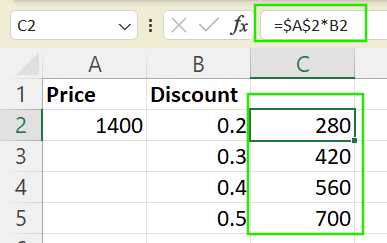
Example of absolute reference in Excel. Image by Author.
When editing a formula, placing the cursor on a cell reference and pressing F4 will toggle through the following options:
-
$A$1: Absolute reference that locks both column and row. -
A$1: Mixed reference which locks only the row. -
$A1: Mixed reference which locks only the column. -
A1: Relative reference with no cell locking.
On a Mac, use Command + T instead of F4 to toggle between reference types.
Understanding the Types of Cell References
Excel offers different types of cell references that control how formulas behave when copied or dragged. Here's a clear breakdown of each type:
Absolute reference
An absolute reference locks both the column and the row, so the reference does not change when a formula is copied or moved to another cell. For example, $A$2 will always point to cell A2, no matter where the formula is placed or dragged.
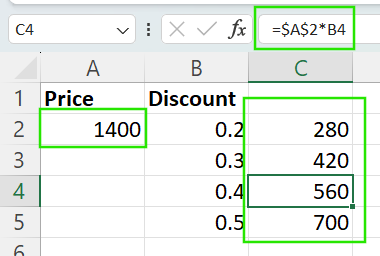
Example of absolute reference in Excel. Image by Author.
Relative reference
A relative reference allows both the column and the row to adjust automatically when the formula is copied or moved. For example, copying =A2 * B2 down one row changes it to =A3 + B3.
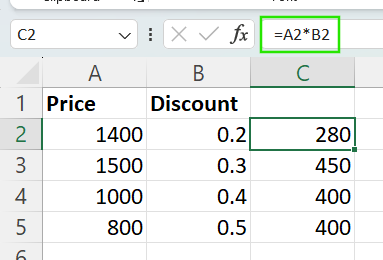
Example of relative reference in Excel. Image by Author.
Mixed reference
A mixed reference locks either the column or the row, but not both:
-
$A1: The column (A) is locked, but the row number changes as you drag the formula vertically. For example, dragging$A1down will result in$A2,$A3, and so on. -
A$1: The row (1) is locked, but the column changes as you drag the formula horizontally. For example, draggingA$1to the right will result inB$1,C$1, and so on.
A named range allows you to assign a custom label to a cell or range, making formulas easier to read and manage.
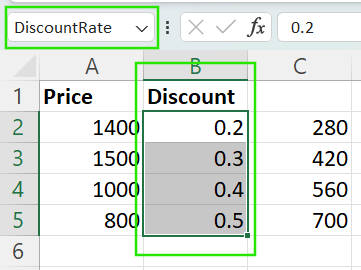
Example of a named range in Excel. Image by Author.
An anchor cell refers to a fixed reference point, often maintained with an absolute reference, to provide consistency in calculations.
Why Use Absolute References?
The following are some reasons you would want to use absolute references:
-
Keep constants stable: Use absolute references to fix values like tax rates, discount factors, or unit prices so they stay the same across multiple formulas.
-
Reference configuration values: In financial models, use absolute references for configuration values such as exchange rates, inflation assumptions, or fixed parameters.
-
Create cleaner, more maintainable spreadsheets: Locking key cells makes formulas easier to read, understand, and audit.
-
Prevent calculation errors: Absolute references act as anchors, ensuring formulas always pull data from the intended cells, even in complex datasets.
Examples to Help You Get Comfortable with Absolute References in Excel
Practicing with real scenarios is the best way to understand how absolute references work. These kinds of examples you might see in our Financial Modeling in Excel course.
Tax rate application
Suppose you have a fixed tax rate in cell B2, and a list of item prices in column A (A2:A6). To calculate the tax for each item using the absolute reference, enter the following formula in cell C2. Then drag the formula down. The A2 reference will adjust to A3, A4, and so on, but $B$1 stays fixed on the tax rate.
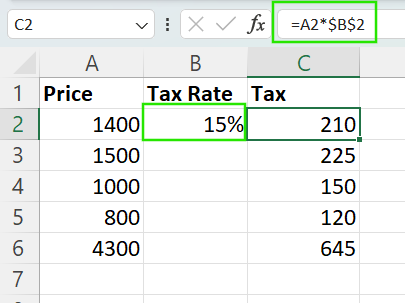
Discount application
Imagine you have a discount rate stored in cell B2 and a list of original prices in column A (A2:A6). To calculate the discounted price for each item, use the formula =A2*(1-$B$2). Copying this formula down keeps the discount rate locked while applying it to each item’s price.
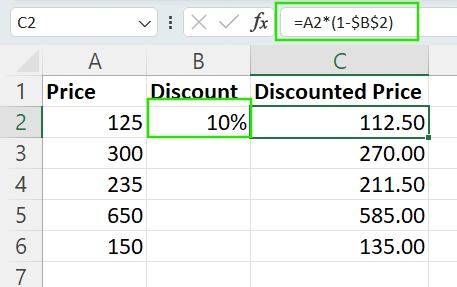
Summing a range with a constant multiplier
Suppose you want to sum a range of values in A2:A8 and multiply the total by a constant factor stored in C2. Use the following formula:
=SUM(A2:A8)*$C$2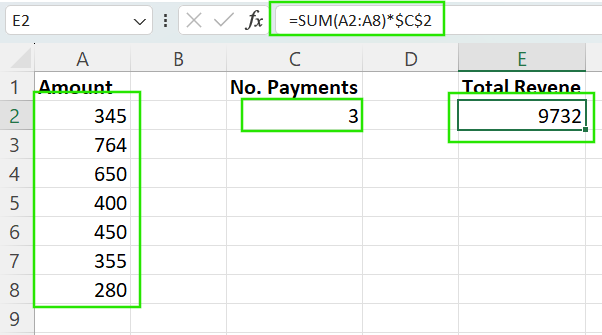
This keeps the multiplier fixed, no matter where you move or copy the formula.
Tips for Using Absolute References Effectively
As you have seen, using absolute references wisely can make your spreadsheets more accurate, readable, and easier to maintain. Here are some additional tips I've found useful.
-
Organize constants in a separate section: Place fixed values like tax rates, discount percentages, or currency conversion rates in a clearly labeled area of your sheet to make them easy to find, reference, and update.
-
Combine absolute and relative references: Mixed formulas like
$A1orB$2let you lock only part of a reference, giving you more flexibility when dragging formulas across rows or columns. -
Double-check references after copying formulas: When copying formulas across different parts of your sheet, verify that your absolute references still point to the correct cells and haven't been adjusted incorrectly.
-
Consider using named ranges: Named ranges let you assign a descriptive name to a cell or range, such as
TaxRate, improving readability and reducing errors, especially in large or complex formulas.
Common Mistakes to Avoid
Sometimes, even experienced Excel users can make small reference errors that lead to big calculation problems. Here are some common mistakes to watch out for:
-
Forgetting to lock key references: Copying a formula without locking important values can lead to incorrect results as the reference shifts. Always ensure you lock your references as required.
-
Overusing absolute references: While locking values can be helpful, using too many absolute references can make formulas rigid and harder to adapt. Use them only where consistency is truly needed.
-
Locking the wrong part in mixed references: Accidentally locking the wrong part of a mixed reference can break formulas. Use the F4 Key in Windows or Command + T in Mac to cycle through reference types quickly and avoid manual errors.
Conclusion
Mastering absolute references is important for any Excel user aiming to build dynamic, flexible, and error-free spreadsheets. By understanding when and how to lock cells, you can create formulas that adapt intelligently while keeping key values consistent. I encourage you to practice using absolute references in real-world scenarios, like applying tax rates, discounts, or constants, to build confidence and sharpen your Excel skills.
I recommend taking our Data Analysis in Excel course to keep practicing your skills and our Excel Fundamentals skill track to learn advanced data cleaning techniques and the functions available in the latest Excel versions.
Advance Your Career with Excel
Gain the skills to maximize Excel—no experience required.
Excel FAQs
What is an absolute reference in Excel?
A cell reference that remains fixed when a formula is copied.
How do you create an absolute reference?
Add $ before the column and row. For example, $A$1.
What’s the difference between absolute and relative references?
Relative references change when copied; absolute references remain fixed even when cells change.
What are mixed references in Excel?
Mixed references are the references that lock only the row, like A$1 or column like $A1.
How do I toggle between reference types quickly?
Press F4 (Windows) or Command + T (Mac) to cycle through absolute, mixed, and relative references.

